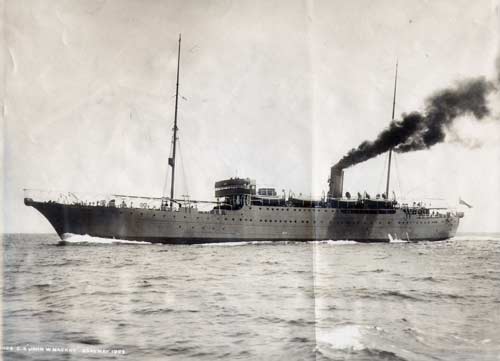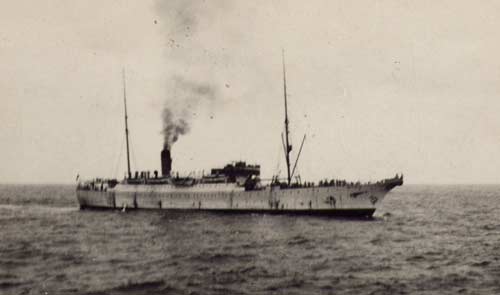|
CS JOHN W. MACKAY
[Official Number 146571]
|

CS John W Mackay 23rd May 1922
Image courtesy of Bill Holly
|
Built in 1922 by Swan, Hunter & Wigham Richardson
Ltd.
Length 361 ft 8 in Breadth 48 ft 1in Draught 25 ft
4 in Gross tonnage 4064
Built for the Commercial Cable Company and based at
Halifax, Nova Scotia on Atlantic repair duties. Fitted with four tanks
one 31 feet in diameter the others 32 feet diameter providing a storage
capacity of 50000 cubic feet. The Telegraph Construction and Maintenance
Company provided the cable machinery which consisted of a double combined
picking up-paying out gear. Three bow sheaves and one stern sheave were
fitted.

CS John W Mackay. The speck in the water by the bow is a small boat from CS Faraday (2),
sent over to get mail and fresh stores during the repair of cables damaged in the North Atlantic earthquake of November 1929.
|
In 1929 after a major subterranean upheaval on the sea bed between
the Azores and Newfoundland the vessel was one of seven cable ships chartered
to carry out repairs. The other ships were Faraday (2), Dominia, Cyrus Field, Lord Kelvin, All America and Edouard
Jeramec.
In the early part of WW2 John W. Mackay was
stationed at Halifax, Nova Scotia for repair work in the Atlantic. In
1942 the Admiralty requisitioned her for cable laying in the Persian Gulf,
Eastern Mediterranean and later the Pacific Ocean. Due to a shortage of
cable the first task undertaken was the recovery of 450 nm of cable off
Cape Verde Islands belonging to Italcable. This took three weeks working
both day and night all the time under the threat from 'U' boats. After
the war it was back to normal duties, cable maintenance, in the North
Atlantic.
For an insight into life on board CS John W. Mackay in late 1947, see these details of an officer’s expenses during a four month expedition.

Undated photograph of the John W Mackay with a full load of cable
Image courtesy of David Watson |
In 1965 the ship underwent a major refit; the bow
sheaves were increased to 7ft 3in diameter to enable the laying of flexible
repeaters and a five sheave 'V' gear was fitted astern. The No 1 tank
was increased in height, increasing coiling capacity to 57900 cubic feet.
All this was carried out to enable the laying of coaxial cable. Standard
Telephones & Cables Ltd. then chartered the ship on a long term basis
for cable laying.
During the laying of SAT 1 John W. Mackay spent
a total of 300 days at sea with only periodic visits to port to restock
with food and water. Duties included buoying the route 1200 nm at a time
then ensuring that CS Mercury found those buoys while laying the
main cable. Similar work was carried out for HMTS Monarch (4) during
the laying of the UK - Portugal link.
See David Watson's memoirs for stories about the John W Mackay while laying SAT 1.

CS John W Mackay in Malta, 1969, after the Sicily-Libya lay
Image courtesy of David Watson |
In 1977 after 55 years of cable work the ship was
laid up at Greenwich. It was intended to preserve the vessel as part of
the Dockland Museum in the West India Docks, and in 1990 the ship was
moved to a dry dock at Hebburn on Tyne for possible preservation (see below). However,
in 1994 she was finally sold for scrap to Turkish shipbreakers.

June 1983, CS John W. Mackay on the River Thames just below the National Maritime Museum, Greenwich. Laid up here from 1977 until 1990 when moved to Hebburn on Tyne. |
Site visitor Mike McKenny visited the Leyal Demtas salvage yard in Turkey after the ship was broken up, and was shown this grapnel from the John W Mackay in the owner's garden:
_s.jpg)
Cable grapnel from CS John W Mackay
Image courtesy of and copyright © 2019 Mike McKenny |
Stewart Ash notes: “The roller is set on the extensions each side, below the flukes, to prevent the cable forming too tight a bend over the fluke and being cut through during recovery. This type of grapnel was used for recovery of deep-water armoured telegraph cable.”
CABLE WORK
| 1924 |
Waterville, Ireland - Weston super
Mare, England |
| 1929 |
See above notes |
| 1939-42 |
See above notes |
| 1944 |
Carrying out work for the US Navy |
| 1950 |
Newfoundland - Greenland “Hotline” for USAF |
| 1959 |
TAT-2, assisted HMTS Monarch (4) after the loss of CS Ocean Layer |
| 1962 |
SCOTICE with HMTS Alert (4) |
| 1965 |
Spain - Gran Canaria |
| 1966 |
Grand Bahama Island - San Salvador
- Grand Turk for USAF |
| 1967 |
Cape Kennedy - Grand Bahama Island
for USAF |
| 1968 |
Agrigento, Sicily - Tripoli, Libya |
| 1969 |
SAT 1 Sesimbra, Portugal - Tenerife
- Cape Verde Islands - Ascension - Cape Town, South Africa with CS Mercury. Laid all shore ends. |
| 1969 |
Goonhilly, England - Sesimbra, Portugal
with HMTS Monarch (4) |
| 1969 |
Burg, Germany - Malmo, Sweden |
| 1969 |
Civitavecchia, Rome - Golfo di Aranchi, Sardinia |
| 1969 |
Pisa, Italy - Barcelona, Spain |
| 1970 |
MAT 1 Estapona, Spain - Palo, Italy |
| 1971 |
TRANSCAN Gran Canaria - Fuerteventura
- Lanzarote |
| 1971 |
Barcelona - Majorca |
| 1971 |
Lerwick, Shetland Islands - Thorshavn,
Faroe Islands |
| 1971 |
Catanzaro, Italy - Alexandria, Egypt |
| 1972 |
PENCAN 2 Extension: Santa Cruz de Tenerife - Las Palmas |
| 1972 |
Sesimbra, Portugal - Madeira |
| 1973 |
St Thomas, US Virgin Is - St Maarten
- Curacao, Dutch Antilles |
| 1974 |
Civitavecchia, Italy - Cagliari, Sardinia |
| 1975 |
TELPAL Palo, Italy - Tel Aviv, Israel |
| 1975 |
Rome, Italy - Palermo, Italy with CS Alert (4) |
| 1975 |
Cairns, Australia - Port Moresby,
Papua New Guinea |

John W. Mackay on the Tyne
Restoration of the steam-powered cable-laying ship John W. Mackay is being carried out at Hebburn-on-Tyne by the Association of Maritime and Related Charities. The work involves repairs to the ship's hull and wooden deck, and the provision of an exhibition area. It is hoped that the project will be completed in time for the John W. Mackay to be an exhibit at the National Garden Festival at Gateshead in 1990. (Photo and report by Alan Sparrow)
Thanks to Jim Jones for supplying this magazine clipping. |
Jim Jones tells this story about the declining days of the Mackay:
It was planned that when Charles & Diana got married they would travel down the Thames on the royal yacht Britannia. But the John W. Mackay, moored at Greenwich, was in a real sorry state to look at. So as the royal couple would be followed down river by the world's press, STC had one side of the ship completely repainted. Can you imagine: rusty hulk one side, perfect the other side - how sad can you get?
(To help explain below: Mooring dolphins were constructed out in the river Thames so when cable ships were loaded they didn't bottom out.)
A while after the Royal Wedding, the bow of the Mackay started to drift away from the dolphins that the ship was tied up to. I got the call to go out and look see. Myself and Bill Grant, then carpenter's mate ( who had a stiff leg), rowed out to the ship. We climbed 30ft up onto the dolphins (low tide) and found that the king post (a 2ft-square timber part of the dolphins that was pounded into the river bed and used for tying ships up) had started breaking away at the top. This meant that only the stern of the Mackay was properly tied up. The ship would be okay until the change of tide, which would drag the bow out into the river, and if this happened the stern ropes could snap and the ship would drift off down river.
We got back as quickly as possible and reported the problem. I suggested Sherborn's River Construction, or a river tug to stand by ready to be called in pretty quick, as disaster could happen any time . The reply was: "See what you can do." "What, the two of us? One 60yrs old, with a stiff leg, and with no heavy hauling equipment. You must be joking!" It was like talking to a brick wall, and I could see they couldn't care less.
I said, "Come on, Bill, let's go."
We went to the maintenance engineers' workshop and fortunately found some heavy angle-iron and large steel studding, and managed to make a frame to go over the broken part of the king post on the dolphins. With a bit of luck this would bolt on and pull the partly broken timber back into place. We got back to the dolphins, dragged the metal frames up from the row boat onto the deck of the dolphins, bolted the metal on, and it worked.
Bill then rowed over, boarded the John W. Mackay, and threw a line over. I pulled the tie rope over and put it round the king post. Bill, being an ex-London docker, used his skills to somehow pull 4000 tons of ship back onto the dolphins - manually, as no equipment on the ship was working. This was done approximately two hours before the tide was due to change.
We stayed on and waited till the tide changed. After a couple of hours the ship was still in place and we breathed a sigh of relief. No one came to check how the ship was, or even to check us in case we fell into the river!
Sherborn's River Construction arrived months later and re-repaired the dolphins.
|

